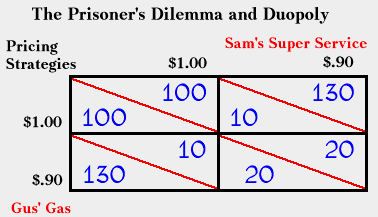The Theory of Few Sellers
Monopoly is a theory of a market with one seller and many buyers. Supply and demand is the theory of a market with many sellers and many buyers. Neither theory tells us what happens when there is oligopoly, that is, more than one seller, but fewer than many. What, for example, happens if there are two sellers, or duopoly? Although many economists suspect that the results of two sellers are more similar to those of one seller than to those of many sellers, the problem of interdependence has thwarted economists' attempts to develop a simple, clear theory that proves this suspicion. When there are only a few sellers, each recognizes that his decisions affect others who may react to what he does.
This problem of interdependence can be shown in terms of game theory in a situation that has the structure of the prisoners' dilemma. The table below shows the pricing options of the only two gas stations in an isolated town. The payoffs in the center are profits. If both stations charge high prices, the joint profits are maximized. However, each has a temptation to cut prices to get to a more favorable corner. If one of them gives in to this temptation, it may start a gas price war as the other firm must retaliate. They then end in the least favorable position of lowest joint profits. We could expand the table to show what would happen if they cut prices even further, to $.80, and we would see that this cut would make them both still worse off. Gas price wars do break out occasionally, but they usually do not last long. Rather quickly the firms realize the futility of the fight and try to return to the original position.

There may be no equilibrium solution in a situation of this sort. Rather, there may be a period of collusion in which firms agree (though it may be an unspoken agreement) to keep prices high. Then, the collusion may disintegrate as firms begin cheating and finally a new period of collusion may begin. Whether sellers collude or compete will depend on many factors that can be difficult to measure and put into a theory, such as the number of sellers, their personalities, whether they have equal or unequal shares of the market, whether their costs are the same, the ease of cheating and of detecting cheating, and whether the sellers can compete on nonprice bases such as service and quality.
A thorough examination of the possibilities of oligopolistic strategies and how well they fit observed behavior of real-world oligopolies is a large and controversial subject that is beyond the scope of these readings. The important point concerning economic efficiency is that if oligopolists perceive their demand curves as downward-sloping (that is, if they take into account that the amount they produce will have a significant effect on the price they can charge), their marginal revenue curves will lie below their demand curves and they will restrict output relative to what an industry of price takers would. Thus, there will be an efficiency loss involved. Most economists use the term "market power" to describe the ability of any price maker to set price.1
When the possession of market power is profitable, it should attract new entrants into the industry. If entry is easy, then the existence of very few or even only one firm may not result in economic inefficiency. The threat of potential entry may be enough competition to keep the industry operating at or close to the competitive solution. In this case, the market is a contestable market. However, if there are significant barriers to entry, the threat of competition is less. Barriers to entry exist when there are sunk costs--expenses that cannot be recovered once a firm has entered the industry. Where these costs are high, the industry probably operates as the theory of monopoly suggests it will.
Barriers to entry can take several forms. They will exist if large amounts of specialized machinery are required to enter an industry and resale of that machinery is difficult. They will exist if a firm must establish a reputation for the quality or reliability of a product. They will also exist if a firm must expend resources in order to get governmental approval to enter. In all of these cases, the barriers to entry can be viewed as sunk costs.2
The theory of contestable markets suggests that even if there is only one seller, the seller may be forced to act as if there were many more. In contrast, there are times when great numbers of sellers are able to organize and act as a unified seller. Sellers have the incentive to act in this way because it will increase profits. The key to their success is their ability to restrict sales.
One place that restrictions on the market are important is in the labor market.
1 Although the word "power" usually implies the ability to use force, the possessor of market power usually does not possess this ability. A monopolist cannot usually fine, imprison, or physically harm someone who does not do what the monopolist wants. However, the term "market power" is widely used and there seems to be no good alternative. Hence, we will use it.
2 Some economists also treat situations in which there is economic rent or producers' surplus as barriers to entry. Rent exists when some resource is especially good for a particular use. Land of special fertility, with rare ores, or with unusually good location is difficult to compete against, as are people with special talents.
Copyright Robert Schenk